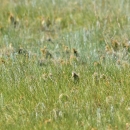About Us
Hewitt Lake National Wildlife Refuge was established on March 7, 1938 by Executive Order No. 7833 as a Migratory Waterfowl Refuge. The general topography is rolling, mixed-grass prairie with the major drainage running in an easterly direction. The lake, enhanced by an earthen dam, creates a shallow seasonal wetland. In most years the lake goes dry by late summer, but during the spring and after spring run-off, the lake attracts thousands of migratory birds.
Natural gas exploration and extraction occurs within the refuge boundary and surrounding area. The refuge contains a large gas field in which the Federal Government owns much of the mineral rights. The Executive order establishing the refuge permitted oil and gas leasing. Specifically, the Executive order noted that the refuge land was within the known geologic structure of a producing gas field and state that, “nothing should affect the disposition of its oil and gas deposits under the Mineral Leasing Act of 1920.” In addition, at the time it was established, the Department of Interior regulations did not prohibit oil and Gas leasing on refuge lands.
Our Mission
Refuge Purpose
Each unit of the National Wildlife Refuge System is established to serve a statutory purpose that targets the conservation of native species dependent on its lands and waters. All activities on those acres are reviewed for compatibility with this statutory purpose.
Hewitt Lake National Wildlife Refuge was established as "a refuge and breeding ground for migratory birds and other wildlife" by Executive Order 7833, issued on March 7, 1938.
Our History
The history of Hewitt Lake National Wildlife Refuge is tied to the Emergency Relief Act and the Works Progress Administration program. Created by President Franklin D. Roosevelt during the Great Depression and the Dust Bowl era of the mid-1930s, these programs were developed to employ the maximum number of people to work on public lands. During the Dust Bowl era, the country and the government were very focused on capturing and conserving water for wildlife, particularly waterfowl, and agricultural operations. Water impoundments were popularized when the connection was made to employing out-of-work citizens to build the structures needed to impound and manage limited water resources.





